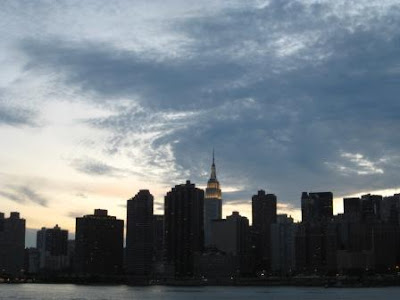As I rode this evening, I was thinking about what "Velouria" posted yesterday on her Lovely Bicycle! blog. In it, she talks about bicycles with "trusses": an old design that is apparently being revived by a few small builders like A.N.T.
The "truss" frames she showed are indeed lovely, and she mentioned that the bicycles that inspired them were built about 100 years ago and patterned after truss bridges.
You simply can't spend any time in New York without going over some bridge or another. Even the sorts of people who leave Manhattan only to go to Europe pass over stone or girdered spans over streets and roads that were, in some cases, streams or small rivers before they were filled in.
And I can't help but to think of bicycles themselves as bridges. After all, there is something "on the other side" of every bike ride. This evening, it happened to be the wonders of New York--and Nature's-- architecture:
You all know the building in the center: It's the one phoenetically-challenged kids of my generation used to call "the En-tire State Building." I took this admittedly primitive photo from this spot:
The pier in the photo is part of Gantry Plaza State Park in Long Island City. Of course, the opportunity to experience a nautical breeze while taking in one of the best possible views of the Manhattan skyline is reason enough to go there. It also happens to be just a few blocks from the PS 1 Contemporary Art Center.
What's interesting about the park and the museum--and much of the rest of the neighborhood--is that about 15 years ago, they were part of an industrial area, much of which was decaying or derelict. Stolen cars were abandoned there; indeed, the area was, as I understand, the setting for part of the Grand Theft Auto series. In 1885, the Long Island City docks bustled with shipments of Long Island produce headed for Manhattan and points beyond; a hundred years later, those docks were all but abandoned.
However, even in its dilapidated state, the waterfront and some of the buildings on it shared a trait with those classic and classy bicycles that people sometimes find in basements and barns. That trait was perhaps best expressed by Victor Hugo in Les Miserables: "Le beau est aussi utile que l'utile. Plus peut-etre." ("The beautiful is as useful as the useful. Perhaps more so.")
I apologize that my keyboard doesn't have those fancy and pretty markings the French and other speakers of non-English languages like to put on their words. My favorite one in French is the "hat," or accent circumflex. Since I couldn't type one, I'll give you a photograph of one. In fact, this photo has a whole bunch of them:
Even if it's named after an auto company that got bailed out twice, it's still beautiful. In fact, the Chrysler Building is still my favorite skyscraper, and one of my favorite buildings in New York. This one ain't bad, either:
Still, to me, nothing constructed by humans compares to a bridge.
And the bicycle is a bridge for many of us.





